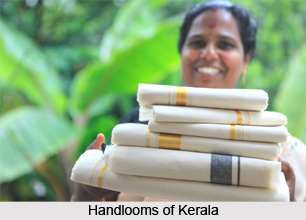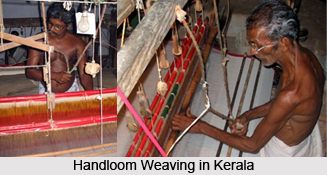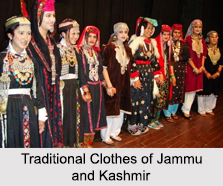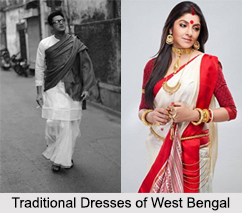 Traditional handloom weaving dominates Kerala`s textile industry and forms a major part of Kerala"s identity. It provides livelihood to almost 2 lakh weavers in Kerala, 75% of them in co operative line, thus supporting Kerala"s economy. It"s handloom fabrics are recognized throughout the world for their quality, variety, unique designs and strength. It is even difficult to recognize whether the products are hand woven or electrically woven. Kuthampully, Balaramapuram and Chendamangalam are the three major weaving centres in the state. Kerala State Handloom Development Corporation provides material and financial support to the weavers individually.
Traditional handloom weaving dominates Kerala`s textile industry and forms a major part of Kerala"s identity. It provides livelihood to almost 2 lakh weavers in Kerala, 75% of them in co operative line, thus supporting Kerala"s economy. It"s handloom fabrics are recognized throughout the world for their quality, variety, unique designs and strength. It is even difficult to recognize whether the products are hand woven or electrically woven. Kuthampully, Balaramapuram and Chendamangalam are the three major weaving centres in the state. Kerala State Handloom Development Corporation provides material and financial support to the weavers individually.
Process of Handloom Weaving in Kerala
Weaving is the process of passing a thread cross-wise (the weft) through alternate lengths of thread (the warp), creating the fabric. On a handloom, this is done by hand rather than being driven by electrical power.
The main communities in Kerala engaged in weaving are Saliyas and Devangas. Handloom weaving is mainly concentrated in villages of Kerala and this traditional skill is passed down from one generation to another. The weaving is done in homes or collective weaving sheds by both men and women. The weavers have formed co operative handloom societies to provide major supplies in terms of yarns, weaving equipments and technical information. Pit looms, frame looms and jacquard or dobby looms are usually used for weaving.
The yarn is given a scouring treatment in closed earthen or iron vessels. The scouring is done with caustic soda and soda ash and is steeped over a night. Then the following day the yarn is taken out and washed in water. A half bleaching is given to the yarn if it is intended for dyeing pastel shades. Bleaching agents used in this process are sodium hypochlorate or hidrogen peroxide. The bleached yarns are further brightened by optical brightening agents namely tinopal and ranipal. Another round of souring treatment with hydrochloric acid is done to control its pH value. Natural dyes, reactive, vat and direct dyes are used in the process. If the yarn is single count like 10S or 20s, it is sized using starch. Then the warping machines are used to prepare the warp yarn in sections or vertically. The warp yarn is tightly wound on wooden beams and fitted into looms. Bamboo reeds and metallic reeds are used for denting the warp.
Handloom Products of Kerala
Balaramapuram Sarees, Kuthampully Sarees, Kannur Shirtings and furnishings, Alappuzha Coir Mats, Turkish Towellings and carpets have become Kerala"s identity. Typical hand woven costumes worn in Kerala are Thorthu, Lungi, Saree and Dhoti.
 Thorthu is a towel fabric made of cotton yarn. Kaili or Lungi is made of cotton and sometimes in poly cotton blends too. It is worn by the gents of Kerala. It is designed in checks or stripes of vivid colour combinations. Saree is woven by using fine yarns. It is worn by ladies. Kerala sarees are well known throughout the world. What makes Kerala sarees unique is the fact that they are hand woven, made out of 100% unbleached cotton and have off white color. Fineness of count in weaving is also characteristic of a typical Kerala saree. Double Mundu or Doudle Dhoti has a small border and cross border. Dark colours are used for these borders. The body of the Dhoti is in off white colour. It is a formal wear for men. Cotton and linen are used to make bed sheets and pillows in fly shuttle frame looms and jaquard looms.
Thorthu is a towel fabric made of cotton yarn. Kaili or Lungi is made of cotton and sometimes in poly cotton blends too. It is worn by the gents of Kerala. It is designed in checks or stripes of vivid colour combinations. Saree is woven by using fine yarns. It is worn by ladies. Kerala sarees are well known throughout the world. What makes Kerala sarees unique is the fact that they are hand woven, made out of 100% unbleached cotton and have off white color. Fineness of count in weaving is also characteristic of a typical Kerala saree. Double Mundu or Doudle Dhoti has a small border and cross border. Dark colours are used for these borders. The body of the Dhoti is in off white colour. It is a formal wear for men. Cotton and linen are used to make bed sheets and pillows in fly shuttle frame looms and jaquard looms.
Ayurvastra or healthy fabrics are now dominating the attention of handloom weavers in which dyeing is done with Ayurvedic herbs and plants not synthetic chemicals. It is manufactured and exported by a 50-year-old Balaramapuram handloom firm Kairali Exports. It is aimed at creating eco-friendly wellness textiles. This effort was initiated by Department of Industries and Commerce and the Department of Government Ayurveda College.
Problems Faced by Handloom Industry in Kerala
A study on handloom industry in Kerala conducted by the Evaluation Division of the State Planning Board specified the problems faced by this industry. Some of the major factors enumerated are indebtedness of weaving societies, shortage of working capital, pending arrears from apex bodies and supply of low quality raw materials from various agencies.
Other general problems highlighted by this study are lack of skill-development training programmes, labour turnover due to excessive physical labour, competition from high quality textile fabrics offered at cheap rates, power looms, dilapidated work sheds, old looms, time lag in modernising the handloom technology and time lag in total wage payment to the workers.
To deal with these problems, Kerala State Handloom Development Corporation (KSHDC) was established to provide regular employment to the weavers in Kerala and improving their standard of living, but it is not evident in their socio-economic conditions. The Government of India also stepped in to improve the conditions of the Kerala handloom industry, in terms of a new scheme called Deen Dayal Hathkargha Prothsahan Yojana (DDHPY). But this effort is not sufficient as the schemes of State would provide more supplements to meet the inadequacies in the quality and wages of people of Kerala.
Related Articles:
Kerela
Sarees of South India
Costumes of Kerala
Ksavu Sarees
Lungi
Dhoti
Cotton Fabric





















